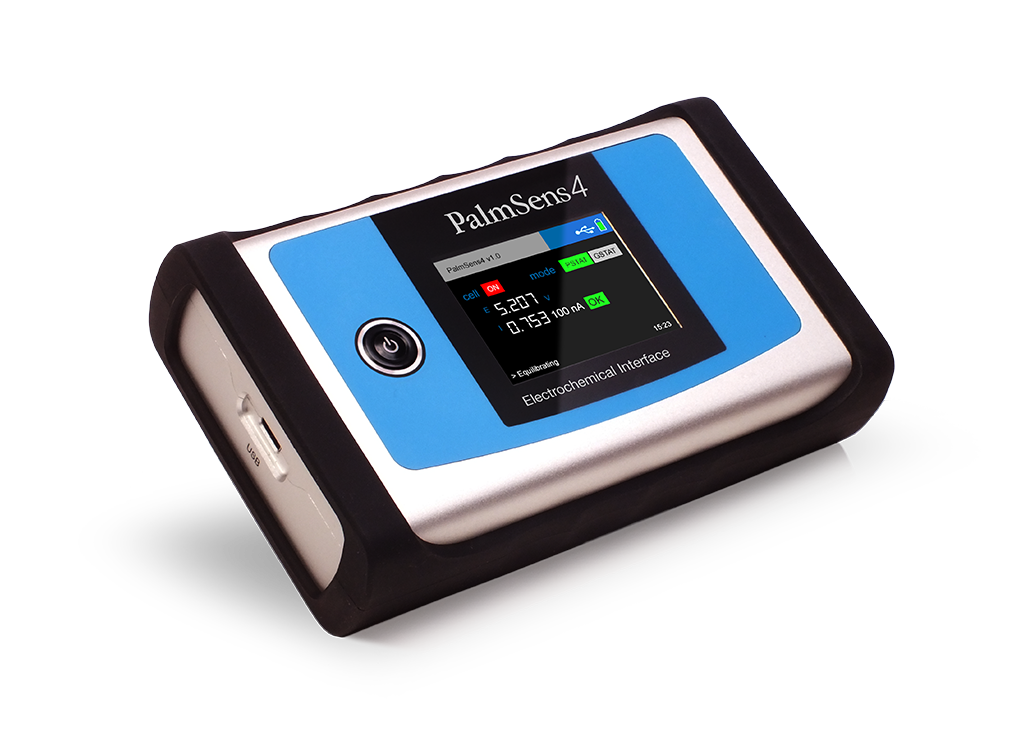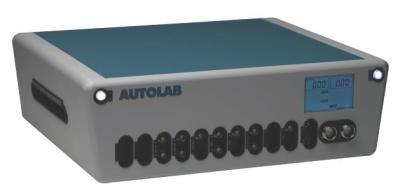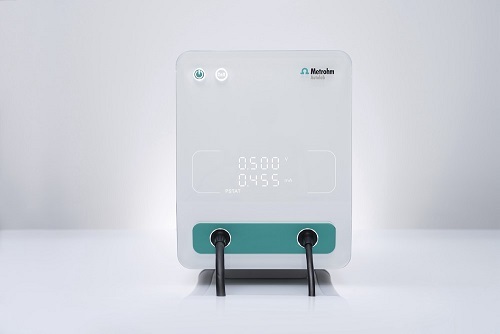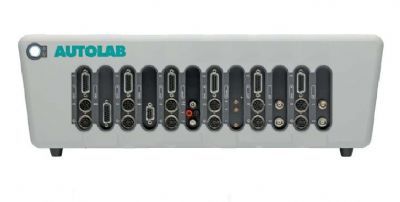方案详情文
智能文字提取功能测试中
开发高能高效的电池技术是推进交通和航空电气化的一个重要方面。然而,电池创新可能需要数年才能实现。就非水性电池电解质溶液而言,在选择多种溶剂、盐及其相对比例时存在许多设计变量,这使得电解质优化工作既费时又费力。为了克服这些问题,研究人员在这项工作中提出了一种将机器人技术(一种名为 "Clio "的定制自动实验)与机器学习(一种名为 "Dragonfly "的基于贝叶斯优化的实验规划器)相结合的实验设计。通过在单盐和三元溶剂设计空间内对电解质电导率进行自主优化,在两个工作日和 42 次实验中确定了六种快速充电的非水电解质溶液。与相同的自动实验所进行的随机搜索相比,这一结果代表了六倍的时间加速。为了验证这些电解液的实际用途,研究人员在 220 mAh 石墨∣∣LiNi0.5Mn0.3Co0.2O2软包电池配置中进行了测试。与使用从设计空间中预先选择的非水电解质溶液的基线实验相比,所有含有机器人开发的电解质的软包电池都显示出更强的快速充电能力。离子电导率通过与对称铂丝相连的 Palmsens4(Palmsens 公司生产的紧凑型电位/恒电位仪和频率分析仪)进行电化学阻抗光谱 (EIS) 测量。在每次离子电导率评估过程中,都通过热电偶测量被测样品的温度,在报告的所有测量中,被测样品的温度都保持在 26 至 28 °C 之间。在一系列电解质中,重复测量同一电解质离子电导率的平均绝对差值为 ± 1.3%。图 1:自动电解质实验--"Clio "示意图。它使用一系列两个程序泵来配料和转移液体样品。配料从供料溶液(a)通过 24 口阀(b),在泵(c)和三通阀(d)的作用下,进入废液容器(e)或带有超声波混合器的共用容器(f)。液体样品经过一个双铂丝电导室,该电导室与 Palmsens4 型恒电位仪(g)、通向质量平衡的三通阀(h)和 Brookfield 粘度计(i)相连。所有 5 V 开关均由 Devantech 继电器 (j) 控制。定制的 Labview 软件 (k) 负责协调所有仪器。手套箱中的氩气通过管道高压输入 (l),以帮助清除封闭的体积。 总之,本文介绍了非水性电池电解液离子导电性的 "闭环 "优化,并缩小了设备差距,在软包电池配置测试中显示出性能改进。研究人员使用贝叶斯实验规划器的工作流程产生了高效的 DOE,在经过充分研究的设计空间中找到了尚未报道的最佳电导率,并揭示了在锂离子电池中具有比直观选择的基线更好的快速充电性能的候选方案。这证明了闭环实验在已探索和未探索的设计空间内发现最佳材料设计的潜力。通过将模拟中的工作流程与随机取样的优化进行比较,估计使用本文的方案总体加速了六倍。研究人员相信,这项工作不仅对电池领域有用,此工作定制设计的机器人平台、实验规划以及与设备测试的集成,对于优化能源应用和材料科学领域的其他自主发现平台也很有价值。原文链接:https://doi.org/10.1038/s41467-022-32938-1nature communicationshttps://doi.org/10.1038/s41467-022-32938-1 Articlehttps://doi.org/10.1038/s41467-022-32938-1 Article Autonomousoptimizationofnon-aqueousLi-ionbatteryelectrolytesviarobotic experimentationandmachinelearningcoupling Received:16January2022 AdarshDave1,2,JaredMitchell2,3,SvenBurke 2,3,HongyiLin 1,2,JayWhitacre2,3 &VenkatasubramanianViswanathan 1,2 Accepted:24August2022 Published online: 27 September 2022 Checkforupdates Developinghigh-energyandeficientbatterytechnologiesisacrucialaspectof advancingtheelectriicationoftransportationandaviation.However,battery innovationscantakeyearstodeliver.Inthecaseofnon-aqueousbattery electrolytesolutions,themanydesignvariablesinselectingmultiplesolvents,saltsandtheirrelativeratiosmakeelectrolyteoptimizationtime-consuming andlaborious.Toovercometheseissues,weproposeinthisworkanexperi-mentaldesignthatcouplesrobotics(acustom-builtautomatedexperiment named"Clio”)tomachine-learning(aBayesianoptimization-basedexperiment plannernamed"Dragonly”).Anautonomousoptimizationoftheelectrolyte conductivityoverasingle-saltandternarysolventdesignspaceidentiiessix fast-chargingnon-aqueouselectrolytesolutionsintwowork-daysandforty-twoexperiments.Thisresultrepresentsasix-foldtimeaccelerationcompared toarandomsearchperformedbythesameautomatedexperiment.Tovalidate thepracticaluseoftheseelectrolytes,wetestedthemina220mAhgraphi-te||LiNi0.5Mn0.3Co0.2O2pouchcellconiguration.Allthepouchcellscontaining therobot-developedelectrolytesdemonstrateimprovedfast-chargingcap-abilityagainstabaselineexperimentthatusesanon-aqueouselectrolyte solutionselectedapriorifromthedesignspace. High-performancebatteriesarecrucialtotheelectriicationoftrans-portationandaviation1,2.However,newbatterydesignscanrequire extensivemanualtestingformaterialoptimization,whichcantake years.Designingamaterialisfundamentallyacomplexfunctionthat takesmaterialformulationasinputandoutputsperformance.Eficient optimizationofsuchablack-boxfunctionviamachinelearninghas beensuccessfullydemonstratedinmanyengineeringdomains,includingcatalyticmaterials3,4,photovoltaics5,6,solid-statematerials7,8,andbattery-chargingprotocols9.Thereisagreatdealofrecent researchoncouplingautomatedexperimentstothesemachine- learningmethods10–14.Thehopeisthat“closed-loop”approaches(i.e.,theautomatedexecutionofexperimentscoupleddirectlytoan experimentplanner,workingintandemtoachieveagoalwithout humanoperatorinluence)displaythefollowingtraitswhencompared tothestandarddesignofmaterialsviahuman-operatedexperi-mentation:(1)closed-loopexperimentsareabletodiscoveroptimal materialdesignswithinagivendesignspace;(2)closed-loopexperi-mentsdiscoveroptimafasterandwithfewerexperiments;(3)closed-loopexperimentsofferaprincipledbasisfordesign-of-experiments (DOE),balancingexploitingdesignregionslikelytohaveoptimal 1DepartmentofMechanicalEngineering,CarnegieMellonUniversity,Pittsburgh,PA15213,USA.2WiltonE.ScottInstituteforEnergyInnovation,Carnegie MellonUniversity,Pittsburgh,PA15213,USA.3DepartmentofMaterialsScienceandEngineering,CarnegieMellonUniversity,Pittsburgh,PA15213,USA.e-mail:whitacre@andrew.cmu.edu;venkvis@cmu.edu performancewithexploringregionsofunknownperformance.These traitshavebeendemonstratedinrelatedields3,6–8,10,11,15,buthavenot yetbeendemonstratedinbatterymaterialdesignoutsideofaqueous electrolytes16. Outofthematerialspresentinabattery,liquidelectrolytesarea particularchallengetooptimize.Therearemanychoicesfor solvent17–19orsalt20,21,eachpotentiallyyieldingvastlydifferentper-formance;optimizedelectrolytesolutionsoftencontainmorethan threeorfourcomponents.Bothspecieschoiceandrelativepropor-tionsofspeciesmatter,creatingahigh-dimensionaldesignspace spanningbotheficientandinadequatebatteryperformance.Battery electrolytescanbeoptimizedfordifferentapplications.Theelec-trolytedesignoftenmustfulillmultiple,competingobjectives withineachapplication22,sooptimaldesignsforrate-capabilitycan differfromoptimaldesignsforcycle-life.Relevanttothiswork,fast-chargingbatteryelectrolytesmustbeabletotransportlithiumions toandintothenegativeelectrodeactivematerialathighcurrent rates(5–10mA/cm2),whichisstronglyassociatedwithbulktransport properties(ionicconductivity,viscosity,diffusivity,cationtransfer-encenumber)andelectrodeinterfacialkinetics(chargetransfer impedance,desolvationdynamics)23,24. Inthiswork,wedeveloparoboticplatformnamed“Clio”,capable ofclosed-loopoptimizationofnonaqueousLi-ionelectrolytesolu-tions.Clioenableshigh-throughputexperimentscharacterizing transportpropertiesoverarangeofsolventsandsalts.Whencon-nectedtoanexperimentplanner,Cliocaneficientlyandautono-mouslyexploreandoptimizeanobjectiveoveragivendesignspace.Weconsideroptimizationforfast-charging,focusinginitiallyonsingle objectiveoptimizationofthebulkionicconductivityasanobjective forimprovingbatteryrate-capabilityperformance.Whilethisaspectis apreliminaryobjectivefunction,theworklowintroducedinthispaper canalsoenableeffectivemulti-objectiveoptimization25ofelectrolytes infuturestudies.Clioautonomouslyoptimizedconductivityover solventmassfractionandsaltmolalityinadesignspacefeaturing:ethylenecarbonate(EC),ethyl-methylcarbonate(EMC),anddimethyl carbonate(DMC)asaternarysolventcombination;andlithiumhexa-luorophosphate(LiPF6)asasingle-saltsystem.Optimalelectrolytes arepassedthroughasequenceoffast-chargingelectrochemicaltests conductedingraphite||LiNi0.5Mn0.3Co0.2O2pouchcells.Theseresults arereportedagainstabaselineelectrolyteselectedapriorifromthe designspace. Resultsanddiscussion ClioisillustratedschematicallyinFig.1,andpicturedinSupplementary Fig.1.Theinstrumentwascustom-builtforautonomousoperationsby theauthorsofthepresentarticleandisessentiallyanautomatedliquid handleratthefrontend(inspiredbypreviouslabautomation26),anda low-throughliquidelectrolytecharacterizationtoolatthebackend.Givenaspeciiedelectrolyte,Cliowillcreateitbymixingtogether feedersolutionsandmeasuretheionicconductivity,viscosity,and densityoftheliquidsample.Theinstrumentisaclosedvolumewithall wettedsurfacescomprisedofpolytetraluoroethylene(PTFE),stain-lesssteel,orplatinum(Pt).Thisgeometryrequiresasolventrinsecycle betweeneachcompositiontested.Acetonitrilewasusedasarinse solventduetoitsprovisionofhighvaporpressure,lowviscosity,and highLiPF6solubility27–29.Theorchestrationfortherinsecyclehasbeen open-sourced(see“Codeavailability”).Allexperimentsarerunintri-plicateasdevelopedduringarinsesolventcontaminationstudy (SupplementaryFig.2).Ionicconductivityismeasuredviaelectro-chemicalimpedancespectroscopy(EIS)measurementsusingaPalm-sens4(compactpotentio/galvanostatandfrequencyanalyzermadeby Palmsens)connectedtosymmetricPtwires.Thetemperatureofthe sampleundertestwastakenduringeachionicconductivityevaluation viathermocouple,andremainedbetween26and28°Cforallmea-surementsreported.Themeanabsolutedifferencebetweenrepeated measurementsoftheionicconductivityofthesameelectrolyteis foundtobe±1.3%acrossarangeofelectrolytes(SupplementaryFigs.3and4).Samplescanberetainedin2-mLvialsforuseincharacterization outsideofClio;thisfeaturewasusedtotestelectrolytesmeasuredto havehighionicconductivityinpouchcellsoutsideofClio. Theliquidsamplewasdosedandtransferredbytwopositive-displacementpumpsmadebyFluidMeteringInc(FMI)calibratedto 5µlperstroke.Comparedtootherpumptypesandtestgeometries,thesevalveless,reversiblepumpsenablemultiplexingofmanyfeeder solutionswithfewervalves,complexity,andcapitalexpenditure.However,singletrackingthroughapumpleadstochallengesin primingthepumpandhandlingviscoussolutions,solutionstowhich arediscussedin“Methods”. LabViewwasusedtoorchestratealldevices-speciicinterfacesare detailedinSupplementaryTable1,andthecodeisavailabletothe public,segregatedintohigh-levelorchestrationVIsforrunsandrinses andlow-levelcontrolVIsasspeciiedintheREADME.Theautonomous experimentliteraturehasalreadyexploredC++/ROSandPython Fig.1|Schematicdiagramofautomatedelectrolyteexperiment—“Clio”.Ituses aseriesoftwoprogrammaticpumpstodoseandtransferaliquidsample.Dosing occursfromfeedersolutions(a)througha24-portvalve(b)mediatedbypumps(c)andathree-wayvalve(d)intoeitherawastevessel(e)oracommonvesselwitha sonicatorformixing(f).TransfertakestheliquidsamplethroughadualPt-wire conductivitychamberconnectedtoaPalmsens4potentiostat(g),athree-wayvalve leadingtoamassbalance(h),andaBrookieldviscometer(i).All5Vswitchingis handledbyaDevantechrelay(j).CustomLabviewsoftware(k)orchestratesall instruments.Argonfromthegloveboxispipedinathighpressure(l)toassistin clearingouttheclosedvolume. options30,31forexperimentmanagement.LabViewwasselectedfor easeofdevelopment,managementofmultipleVISAconnectionsvia NI-MAX,andreliablylowlatency(singlemilliseconds)fortriggering callstothesemultipleVISAconnections—thislastpointiscrucialfor Clioashigh-pressureargoncontactsmanyvalves,pumps,andinstru-mentsintherinseprocess.However,LabViewisnaturallylessmodular,shareable,andmaintainablethantheotherlanguages,andlacksver-sioncontrolentirely;thus,itmaybeworthwhiletofurtherassess LabViewagainsttheotherframeworksalreadypresent.Clioiscon-trolledoverHTTPviaaLabViewRESTAPI,whereaclientrequests experimentsfromClioinJSONandClioreturnsexperimentalresults.Thisenablesfacileintegrationwithanyexperimentplanner.Aman-agementlayerhandlinginventoryvolumes,chemicalconversions,grid creation,andHTTPsessionmanagementwasdesignedinPython—this codeismadepubliclyavailable.FurtherdetailsonClio’shardware,software,andoperationarecontainedin“Methods”. AsystemofternarysolventsfeaturingEC,EMC,andDMCwith LiPF6assaltwaschosenforstudy.Thisisawell-knownspacefor electrolytedesignandanappealingdomaintodemonstrateanovel experimentalmethod.EC-EMC30–70%massfractionwith1.1mol LiPF6perkilogramsolventwaschosenaprioriasabaseline,asEMCis commonlychosenasaco-solventinrelevantliteraturetobenchmark electrolytetransportproperties32–34. Dragonly—an open-source Bayesian optimization package designedforblack-boxoptimization25,35—isusedastheexperiment plannerinthiswork.Dragonly’sadaptivesamplingstrategyandbroad supportfordiscretizedandconstraineddomainswereofinterestto theauthorsofthepresentarticle.Theexperimentdomainwasrepre-sentedtoDragonlybythreeaxes:(1)ECmassfraction,(2)DMCco-solventratio,calculatedas(massfractionofDMC)/(1−massfractionof EC),and(3)LiPF6molality.Axis1waslimitedtoECmassfractionsof 30%to50%,andaxis2waslimitedbetween0and2molsLiPF6per kilogramsolvent,keepingwithconventionalchoicesfornon-aqueous liquidelectrolytedesign.Eachaxiswassplitinto10–12equivalently spacedlevels,creatingmorethan1000pointswithinthedomainto search.Dragonlyoptimizedforionicconductivityover42experi-ments.Thisoptimizationcampaignwasinitializedwithivesamples drawnrandomlyfromaspace-constrainedtothetopandbottomfaces ofthedesignspace(i.e.,EC-EMCandEC-DMCelectrolytesonly)—subsequentrandomsamplingwasnotsubjecttothisconstraint.The electrolytesinvestigatedareillustratedaspointsinthethree-dimensionaldesignspaceinFigs.2and3. AnadaptiveDOEisconstructedwiththreedifferentacquisition functions evaluated over a Gaussianprocess regression-based Fig.2|Samplinginanelectrolytedesignspaceduringoptimization.AThe speciicpoints(electrolytes)sampledbyClioduringautonomousoptimizationof ionicconductivityinanEC-EMC-DMC,LiPF6designspace.Theblackcircleindicates baselineelectrolyteselectedapriori(EC/EMC30%/70%bymass,1.1mLiPF6). surrogate model—expected improvement, top-two expected improvement,andupper-conidencebound.Thesesamplingalgo-rithmsroughlybalanceexplorationandexploitation.Weinterspersed theoptimizationrunwithperiodicrandomsamplingtofurtherfavor exploration.Figure2illustratesaconvergenceonanionicconductivity optimumwithin15experiments.Theoptimizerevaluatesmainlyinthe highDMCregioncomparedtothehighEMCregion,generallyinthe middlebandofsaltconcentrationbetween0.7to1.3molsLiPF6per kilogramsolvent(knowntobeneartheconcentrationofpeakcon-ductivityinstandardnon-aqueousLi-ionelectrolytesolutions).Sam-plesfromthehighandlowsalt,mixedDMC-EMCregionscouldalsobe desired. Figure3showsmeasuredionicconductivitiesinthethree-dimensionaldesignspace.LinearcarbonateslikeDMCaremixed withcycliccarbonateslikeECtolowerviscosityandincreaseionic conductivity22,butmorerecentstudiesrevealthationicconductivity canalsoincreasewithhigherdielectricconstantasitimprovesion dissociation(e.g.,ECoverDMC,DMCoverEMC)36.Ourstudyindicates thattheionicconductivityoptimumoftheEC:DMC:EMCLiPF6system at26–28°CisfoundatEC:DMC40:60bymass,0.9mLiPF6with 13.7mScm−1(goldarrowinFig.3).Furtherexperimentswerecon-ductedontheEC:DMCfaceofthedesignspacealongthe30%,40%,and50%byECmasscontours,conirmingthisoptimuminthisdesign space(SupplementaryFigs.5and6).Theoreticalcalculationscon-ductedwiththeAdvancedElectrolyteModel(AEM;ahighlyaccurate modelfornonaqueouselectrolytetransportproperties37,38)alsoshow ahigherionicconductivityinthe40%ECblendcomparedto30%or 50%—thiscouldbeduetotheimprovediondissociationinthe40%comparedtothe30%,andloweredviscosityinthe40%relativetothe 50%(SupplementaryFig.7). Outof42evaluations,sevencandidateelectrolyteswerepicked forfollow-upLi-ioncellassemblyandtesting.Threeofthehighest ionicconductivityelectrolyteswerechosen(blendsA,C,andFin Fig.3),asweretwohigher-saltconcentrationelectrolyteswith>10mS/cm(blendsBandE)andonelower-saltconcentrationelectrolytewith >10mS/cm(blendD).Asmentionedabove,EC-EMC30–70%by weight,LiPF61mwasabaselineelectrolytedenotedblendG.Thecell-testingcandidatesaregivenwiththeircolorcodesinTable1.Asuiteof testsonsmallpouchcellswasdevisedtotestelectrolytecandidatefor fast-chargingcapability.Drycellsof220mAhcapacitywerereceived fromthemanufacturerwithelectrodematerials,currentcollectors,andtabspre-made.Detailedcellspeciications,materials,andproce-duresaregiveninMethods.Toguardagainstcell-to-celldiscrepancies,allcellswereruninatleastpairs.Candidateelectrolytesweremixedby BO BLearningrateofClioduringthisoptimization.Randomsampling(RAND)is interspersedwithBayesianoptimization(BO),biasingtheoptimizationtoward exploringthespace.Dashedblacklineindicatestheconductivityofthebaseline electrolyteasmeasuredbyClio. A D F 日 G Fig.3|Evaluationsoftheelectrolytedesignspace,andelectrolyteschosenfor celltesting.AMeasuredionicconductivities(incolor)ofeachelectrolytesampled byClioduringautonomousoptimizationofionicconductivityinanEC-EMC-DMC,LiPF6designspace.Thegoldarrowindicatesthehighestionicconductivity electrolytefound(EC/DMC40%/60%bymass,0.9mLiPF6).BElectrolytecandi-dateschosenfortestinginpouchcells.BlendsA–FarediscoveredbyClio.BlendG isthebaselineelectrolyte. Table1|Tableofelectrolytecompositionsinvolvedinautonomousoptimization Name Color-code Solvent Mass Fractions LiPF6 Molality lonic conductivity (mS/cm) G EC-EMC 30%-70% 1.1 9.8 A DMC-EC-EMC 45%-50%-5% 1.1 12.2 B DMC-EC 70%-30% 1.5 12.1 C DMC-EC 60%-40% 0.9 12.8 D DMC-EC 50%-50% 0.5 10.8 E DMC-EC 70%-30% 1.3 12.1 F DMC-EC 70%-30% 1.0 12.4 BlendCandFhadthehighestmeasuredionicconductivitiesinthespace;blendBandEhadhighsaltconcentrationsand>10mS/cmionicconductivity;blendDhadalowsaltconcentrationand >10mS/cm.BlendAhadthehighestionicconductivitywithEMCpresent.BlendGwaschosenasabaselineelectrolyteapriori. Clioandroutedintotheretainrack(bluetray,bottomleftofSupple-mentaryFig.1).AhumanoperatoremptiedClio’sretainrackand manuallyinjectedeachelectrolyteintothesedrycells. Cellswereassembledandpreconditioned,thensubjecttoa ive-stepratetestofincreasingconstant-currentchargesupto 10.4mA/cm2(4C),with1.3mA/cm2(0.5C)constant-currentdis-chargesbetweeneachstep,eachfollowedbyconstant-voltage (CV)holdat4.3Vuntilaterminationcurrentof0.7mA/cm2(C/20).Cellswerethenrepeatedlycycledatthehighestchargerateuntil failuredueeithertoovervoltage(>4.5V)orcapacityfade.Further detailsonthiscelltesting—includingcurrentconversionsandcell assembly,preconditioning,andmaterials—aregivenin“Methods”andSupplementaryTable2. Figure4A–Cgivestheresultsfromtherate-testforeachcandidate electrolyte.ElectrolyteblendsoptimizedbyClioshowgreaterorequal dischargecapacityatthe4Cstepcomparedtobaseline,showing greaterusablecapacityputintothecellsatthishighchargingrate (Fig.4B).TheworstcellcontainingaClioelectrolyteshoweda5%improvementondischargecapacityafter4Cchargingcomparedto theworstbaselinecell,andthebestcellwithaClioelectrolyteshowed a13%improvementonthismetriccomparedtothebestbaselinecell (Fig.4C).Capacityfadeduringthesefurther4Cchargecycles,along 0.5C 1.0C 4.0C Fig.4|Li-ioncellperformancewithvariouselectrolytesolutions.AConstant-currentchargecapacityofeachelectrolyte,averagedfromtwocells.BConstant-currentdischargecapacityofeachelectrolyte,averagedfromtwocells.CBarchart ofeachcell'sdischargecapacityafter4Ccharge—cycle7onpanelsAandB. DRelationshipbetweenperformanceat4Crate-teststepandcapacityofcellafter iveback-to-back4Cchargecycles;unilledmarkersarecellsthatdidnotmakeit ivecycles—thelastcyclecapacityisreportedhere. withcoulombiceficiencyandrelatedmetrics,areshowninSupple-mentaryFig.8.Dischargecapacityafterthe4Cstepoftherate-test showscorrelationwithdischargecapacityafterivecyclesof4C charging(Fig.4D). Theseresultsindicatethatourworklowisabletooptimize materialdesignswithinagivendesignspace,anddeliveranoptimum fromacommondesignspace.Betterfast-chargingperformanceover baselineinapouchcellwasrealizedafteronly42experimentaleva-luationsoptimizingforbulkionicconductivity.Similarclosed-loop worklowshavebeendemonstratedintheliteraturetodiscoveropti-malmaterialsfasterorwithfewerexperimentscomparedtorandomor exhaustivesearches8,11,39,40.Thesearefrequentlyassessedwithtwo igures-of-meritwithrespecttorandomsampling—anenhancement factor(therelativeimprovementindiscoveredoptimaoversamples taken)andaccelerationfactor(therelativeimprovementinsamples requiredtoachieveagivenvalueoftheobjective)12,41.Wecalculate thesequantitieswithsimulatedoptimizationsoverthedesignspace multipletimes,usingamachine-learningmodelasthe“black-box function”tobeoptimized.Thismodelwasittodatacalculatedby AEM,andshowsgreatidelitywhenpredictingonpointssampledby Clio(SupplementaryFig.9). CampaignscomparingvariousformsofBayesianoptimizationto randomsamplingareshowninSupplementaryFig.10,outofwhichwe calculateenhancementandaccelerationfactors(EF,AF,respectively).Fortheformofoptimizationusedinthefast-chargingstudy,EF (Fig.5A)isupper-boundedby5%,trendingto2.5%over40samples.Thismaybeduetodesignspace,asshowninSupplementaryFigure11:theobjectivehasasingleoptimumandvariesquitesmoothlywith widebandsofhighconductivitythroughoutthespace.TheAF(Fig.5B)reaches10×onaverageforattheoptimumobjective—again,duetothe smooth,widelydispersedobjectiveinthisdesignspace,AFisnegli-gibleuntil95%ofthemaximumobjective.RelevanttoClioandits precisioninmeasuringconductivity,theAFforachievinga98.5%of themaximumobjectiveisonaverage6xandrangesfrom4.5×–11.5×dependingonindividualruns. Anautomatedworklowalsoaddstimeandmaterialeficiency comparedtohumantesting,detailedinSupplementaryTable3and SupplementaryFig.12.Forrepeatedconductivitymeasurementson twoelectrolytesamples,Cliolikelyperformsmoremeasurements perdaythananaveragehumanoperatorandusesabout30%ofthe volumecomparedtoliteratureequivalents.Still,thisconclusionsug-geststhatfutureworkaimtoimprovetheaccelerationfactorof autonomousexperimentsasphysicalautomationtendstoyieldixed eficiencyimprovementsthatscale,atbest,linearlywithsamplesize.Researcheffortsonapplyingimprovedmachine-learningmethodolo-giestoplanexperimentsincomplexdesignspacesmayunlockgreater overalleficienciesthanfocusingonlaboratoryautomationalone.Already,literaturehasdemonstratedAFsabove20×to1000×11,12,41,implyingthepotentialforhigherAFswhenCliosearchescomplex designspaces. Insummary,wehavedemonstrateda“closed-loop”optimization ofanon-aqueousbatteryelectrolyteforionicconductivityandclose thedevicegaptoshowperformanceimprovementswhentestedin pouch-cellconiguration.OurworklowusingaBayesianexperiment plannerproducesahighlyeficientDOE,indsayet-unreportedcon-ductivityoptimuminawell-studieddesignspace,andrevealscandi-dateswithbetterfast-chargingperformanceinaLi-ioncellthanan intuitivelychosenbaseline.Thisdemonstratesthepotentialofclosed-loopexperimentstodiscoveroptimalmaterialdesignswithinwell-exploredandunexploreddesignspaces.Bycomparingthisworklow insimulationtoarandomlysampledoptimization,weestimateasix-foldoverallaccelerationusingourscheme.Webelievethisworkwillbe usefulbeyondthebatterycommunity;ourcustom-designedrobotic platform,experimentplanning,andintegrationwithdevicetestingwill bevaluableinoptimizingotherautonomousdiscoveryplatformsfor energyapplicationsandmaterialscienceingeneral. Fig.5|Calculationofenhancementfactor(EF)andaccelerationfactor(AF).ThesearecalculatedbasedonthesimulatedoptimizationsshowninSupplemen-taryFig.10.Standarddeviationsarecalculatedfromthespreadofoutcomesofthe Methods Clio:hardwareandmetrology HardwareutilizedinClio’sdesignisseeninFig.1andSupplementary Table1.Thelowpathoftheliquidsampleisdeterminedtwopumps (Fluid Metering Inc. ICST-02) and three three-way valves (Cole–Parmer)thatareswitched,alongwithaQsonicaQ55sonicator (55watt,20kHz)inthemixingvessel,byaDevantechrelay.Crucialto thiswork,ionicconductivityismeasuredusingelectrochemical impedancespectrocopy(EIS)inacustomchamber,aPTFEixturein whichtheliquidsampleillsbetweensymmetricplatinumelectrodes.Compleximpedanceismeasuredativefrequenciesbetween14and 800kHz—therealpartoftheimpedanceatthefrequencywiththe smallestmeasuredphasedifferenceistakenastheresistanceofthe sample.Acellconstantisderivedfromsinglepointcalibrationtoan acetonitrilesolutionofknownionicconductivity(seeSupplementary Fig.2)—inverseresistancedividedbycellconstantisreportedasthe speciicionicconductivityofthesample. Arinsecycleisrequiredbetweensamples,forwhichwechose acetonitrile.ThecontaminationstudyinSupplementaryFigure2showsthat,afterarinse,twoexperimentswillconvergeonthe knownconductivityofastandard.Allexperimentalevaluationsare runintriplicateforthisreason,withtheinaltworunsineachtriplet averagedandreportedasthemeasurement.Therepeatabilityofthe conductivitymeasurementisassessedinSupplementaryFigs.3and 4—120samplesweretakenintriplicateacrossarangeofcarbonate solventsandLiPF6concentrations.Thesewereassessedforthevar-iancebetweenrun2andrun3ineachset,indingameanaveraged percenterrorof1.3%anda95%conidenceintervalof±3.8%. Thetemperatureofthesampleundertestwastakenduringeach conductivityevaluationviaathermocoupleconnectedtothePalm-sens4(18-bitresolutioncombinedpotentiostat,galvanostat,andfre-quencyresponseanalyzer),andremainedbetween26and28°Cforall measurementsreported.Clioiskeptinagloveboxmaintainingadry argonatmosphere,withmoisturelevelsmeasuredevery5mintobe below10partspermillionH2Oandoxygenlevelsremainingbelow100partspermillion. Clio:viscoussolutionhandling,priming Twochallengesofusingasinglevalvelesspumpstomanagedosing andtransferincludeaccuratelydosingsolutionsofwideviscosity rangesandprimingthepump.Asviscosityincreases,thepumpmust randomsamplingbaseline.AEFremainsupper-boundedby5%overtheoptimi-zation.BAFachievesavalueof10onaverageforindingthetrueoptimum,anda valueof6at1.8%ofoptimum(thisisnearClio'sexperimentalprecision). slowdownitsstrokesperminute(RPM)tomaintainitscalibrated microliter-per-strokevalue.ThisisillustratedinSupplementary Fig.13—solutionsofknowndensitiesandviscositiesarepumped throughthedosingpumpatavarietyofRPMs.Theviscosimeterused wasaBrookieldDV-IIPro(coneandspindleviscosimeter,±1%full-rangeaccuracymodelRVDV-II+withRV2spindle).Bymassingthe output,wederiveamicroliter-per-strokevalueandcomparethatto thecalibratedsetting.Thepumpshaveastatedprecisionof0.5%aroundthecalibrationmark;cutoffsforeachviscositylevelwereset conservativelybasedonthisdata.Theresultinglinearcurveisshown inSupplementaryFig.14.Thiscurveishighlydependentontubing diameterandsystempressure—theprimingtubehadaninternaldia-meterof1.016mm,andthefeedervialsfeatureasmallhole(~1.5mm diameter)inthelidstominimizepressuredifferentialwithinthevials.Thesechoicesenabledatop-enddosingviscosityof70centipoisefor Clioassetupinthisstudy,andfurtheroptimizationsforhighervisc-ositydesignspacescanbediscussedinfuturework.Forastudy focusingonionicconductivity,transferpumpprecisionisless important.Wesimplyuseda50strokeoffsetfromthedosingpump deratecurvetoaccountforthehighersystempressureinthebackhalf ofClio(markerg–jinFig.1).Moreprecisederatingofthetransfer pumpwillfeatureinfutureworkonviscosity,density,andsurface tensionmeasurements. Thepumpsusedinthisstudyonlyoperateathighaccuracywhen theyareilledwithluid—astateofbeingprimed.Thus,inthedosing process,thepumpmustchangefromprimed(dosingsolution1)to unprimedtoprimedagain(dosingsolution2).Thisrequiresanopen-airvalvemaintainedintheVICIvalve(markerbinFig.1),andathree-wayvalveswitchingbetweenwasteandthemixingvessel(markersd,e,andf,respectively,inFig.1).Furthermore,theauthorsofthepresent articledevelopedaprimingmethodthatalternatesbetweenfeeder solutionandopen-airvalvetode-contaminatesharedlines(presentin dose_FMI.vi)inavolume-eficientmanner.Whenpullingthefeeder solutionthroughtheunprimedpump,theRPMwassloweddownbya factorof3,whichwasvisuallyveriiedtoprimethepumpatthevisc-osityrangepresentinthederatecurve. Clio:software ClioisorchestratedwithasuiteofLabviewtoolsdevelopedin-house,focusingonlow-leveldevicecommunicationandtimings.Labview managesawebhookforsupplyingClioaspeciicDOE;electrolyte compositionsarepassedtothewebhookviaHTTP,andClio’smea-surementsarepassedbackintheresponse.Experimentandinventory managementishandledthroughaPythonAPIthatinterfaceswiththis webhook;anygenericmachine-learningrecommendercaninterface withthisgivenappropriateconigurations.TwoPythonclassesare centraltoCliooperation."Experiment”objectsmanageCliosessions,inventory,andinput/outputwiththeLabviewcontrolsuite.Because Cliomixesbyvolume,"ElectrolyteComposition”objectshandleelec-trolyte representation and conversions needed to transform electrolyte-compositionaxes(molalityandmassfractionsinthiswork)tovolumesoffeedersolutions.Anadditionalscriptisprovidedthat createsgridsofvolumesacrossnfeedersolutionsandconvertsthe gridtocompositionaxesinafast,vectorizedmanner. Electrolyteconversionalsorequiresaprioriestimatesoffeeder solutiondensity;thesevalueswereestimatedviatheAdvancedElec-trolyteModel37,42,ahigh-idelityelectrolytecalculationsoftware,and conirmedbyClio’sdensitymeasurement.Allcodeusedismade available,see“Codeavailability”.TheclientmanagingClioexperi-mentssitsonanAWSEC2instancemanagedbyToyotaResearch Institute. Clio:advancedelectrolytemodel Asmentioned,theAdvancedElectrolyteModel37,42(AEM)wasusedfor avarietyofusesthroughoutthisstudy.AEMisaproprietaryelectrolyte calculationsoftwareprovidingestimationsoftransport,thermo-dynamic,andotherelectrolytequantitiesathighidelityacrossalarge swathofliquidelectrolytesrelevanttobatteryoperation.Inthisstudy,weuseddensitiesandviscositiesfromAEMindosingandderating liquidsamplesinClio.WealsouseddatafromAEMinthesimulated optimizationsfurtherdiscussedbelow. Clio:machinelearning Dragonly—thecode-baseusedforBayesianoptimizationinthisstudy —isopensourceandavailableatgithub.com/dragonly/dragonly. The“live”optimizationarerunbywrappingClio’sExperiment objectintoDragonly’smaximise_functionAPI.Therunwasinitialized with5randomsamplespulledfromtopandbottomfacesofthedesign spacecube(eitherDMCorEMCco-solvent,notamixture)—thistraded offrandomsamplingwithaspace-illingdesigntoseedoptimization.Dragonly’sBayesianoptimization(BO)defaultsettingswereusedfor theliverun—aGaussianprocessregressorformedbytheMaternkernel wasusedwithparametersiteveryexperimentroundwithmaximum likelihoodestimation(MLE).Dragonlyusesanadaptivechoiceof acquisitionfunction35.Theagentstartsoptimizationbysamplinga uniform distribution containing acquisition functions upper-conidencebound(UCB),expectedimprovement(EI),andtop-two expectedimprovement(TTEI).Iftheexperimentrunwiththeacqui-sitionfunctiondrawnfromthissampleimprovestheoptimumfound,thedistributionisincrementedinfavorofthisacquisitionfunction. Weexaminedtheacquisitionfunctiondependenceoftheopti-mizationinsimulatedruns.Thesesimulatedrunswereobtainedby drawing“experiment”datafromaGaussianprocessregressortrained ondatafromtheAdvancedElectrolyteModel(AEM).Thisregressor wasalsoformedbyaMaternkernelanditbyMLE,withthesimulated objectiveshowninSupplementaryFig.11.Resultsforthesesimulated optimizationsareseeninSupplementaryFig.10,averagedover10runs (exceptforrandomsamplingwhichisrun120times).Weseethatall BO-inclusivecampaignsperformmuchbetterthanrandomsampling indiscoveringtheoptimum,anddonotshowstrongdependenceon initializationaseachcampaignendsupdiscoveringthedesignspace optimum.Acquisitionfunctiondependenceisalsoweak,asperfor-mancedifferencesarenegligiblebetweenadaptive,UCB,andTTEI-led campaigns.Often,acquisitionfunctionchoiceiscrucialtogood performance35,butthisdoesnotappeartobethecaseinthissimple designspace.Enhancementfactor(EF)andaccelerationfactor(AF) werecalculatedinanidenticalmannertorecentliterature11,12,41.Stan-darddeviationsarecalculatedfromspreadofoutcomesoftherandom samplingbaseline,asthisvarianceismuchlargerthanvarianceinthe Bayesianoptimizationstrategies. Materialsavailability Thesolventsandsolutesusedinthisinvestigation,exceptforthe baselineelectrolyteandacetonitrile,wereobtainedasanhydrous (<20ppmmoisture),battery-grade(99.9%pure)materialsfromGELON LIBGroup.Materialsusedforpouch-celltestingwerealsoobtained fromtheGELONLIBGroup.Baselineelectrolyteof1.1mLiPF6in EC:EMC30:70andacetonitrilewasobtainedfromSigma-Aldrich,anhydrous(<10ppm)andbattery-grade(99.9%pure). Stockfeedersolutionsweremadeforthisinvestigationthrough irstmakingsolute-freemixturesofsolvents,thengraduallyaddingthe appropriatemassofsolute.Allsolutionsweremixedforaminimumof 30minpastthedissolutionofthelastvisiblesolute.Allmeasurements ofsolventandsoluteweredonebymassusingaDenverInstrumentPI-214.1analyticalbalance(210gcapacity,0.1-mgreadability/repeat-ability).AllsolutionsweremixedwithaVWRbrandmagneticstirbar andmagneticstirplate.Allglasswareandstirbarswerewashedthor-oughlywithacetonitrilebetweensolutionsandwereallowedtodry completelybeforeanymoresolutionsweremade.Miscibilityandco-solubilityscreeningtestswereconductedonthesefeedersolutions beforesolutionswereusedintheteststand.Solutionswereroutinely checkedforthestabilityofdissolvedspeciesandwereroutinely invertedtopreventanystratiicationofthesolutions.Feedersolutions werestoredin60-mlamberglassvialswithSure/Sealseptalids.All materialswerestoredandhandledinadryargonatmospherewith <5ppmmoisture.Allexperimentalprocedures,exceptcelltesting,werealsoconductedinadryargonatmosphere. Celltesting Drypouchcellswithanominalcapacityof220milliampere-hours (mAh)weresourcedfromLinyiGelonLIBCo.Ltd.Cellscontained LiNi0.5Mn0.3Co0.2O2cathodeandgraphiteanode.Cellswererunin duplicateortriplicate—blendCwasonlyrunonceduetoacellpre-sentingwithincorrectcapacity.Fullinformationoncellmaterials,dimensions,compositions,andspeciicationsisgiveninSupplemen-taryTable2. AlltestswerecompletedonNewareBTS-CT-4008-5V12Abattery cyclers.Testingwascarriedoutinanuncontrolledtemperature environment(i.e.,noenvironmental/climacticcontrol).Theaverage labtemperaturewas25°C(±2°C).Cellswerecutopenanddriedina vacuumovenovernightandthentransferredintoaglovebox,with moisturelevelsbelow10partspermillionH2Oandoxygenlevels remainingbelow100partspermillion.Cellswerethenilledwith 0.7mLofelectrolytesbyanEppendorfpipetteandsealedwithaheat sealer.Finally,cellsweretransferredoutforthefollowingfoursteps doneinsequence:(1)cellconstructionfollowedbya36-hrestheldat 1.5Vforelectrolyteiniltration,(2)cellformationatC/20(1C=2.6mA/cm2)symmetricforthreecycles,(3)rate-testwithchargeratesofC/2,1C,2C,4C,thenC/2again,dischargingeachtimeatC/2.Eachconstant-currentchargewascompletedwithaconstant-voltageholdat4.3V untilC/20.EachC/2dischargewascompletedwithaconstant-voltage holdat2.5VuntilC/20.Then,eachcellwassubjectedtoacyclingtest untilfailure—eitherovervoltageof4.5Vduringthechargeorlow capacity.Eachcyclehadachargerateof4C,dischargerateof0.5C,completingeachcycleagainwithaCVholdat4.3V.EachC/2discharge wascompletedwithaconstant-voltageholdat2.5V.Cellswererested for10minbetweeneachstepofthetest.Animageofanexampledry pouchcellwithalengthscale,identicaltothecellsusedinthisstudy,is providedinSupplementaryFig.15.TranslationsofC-ratesintocur-rents,speciiccurrents,andcurrentdensitiesaregiveninSupple-mentaryTable4. AlldatageneratedinthisstudyhavebeendepositedinGithubfor publicaccessionatgithub.com/BattModels/Clio-NatCommData. Codeavailability AllcodegeneratedinthisstudyhavebeendepositedinGithubfor publicaccessionatgithub.com/BattModels/Clio-LabViewControl(for LabView orchestration code) and github.com/BattModels/Clio-PythonAPI(forPythonmanagementAPI). References 1. Sripad,S.&Viswanathan,V.Performancemetricsrequiredofnext-generationbatteriestomakeapracticalelectricsemitruck.ACS EnergyLett.2,1669–1673(2017). 2. Bills,A.,Sripad,S.,Fredericks,W.L.,Singh,M.&Viswanathan,V.Performancemetricsrequiredofnext-generationbatteriesto electrifycommercialaircraft.ACSEnergyLett.5,663–668(2020). 3. Burger,B.etal.Amobileroboticchemist.Nature583,237–241(2020). 4. Zhong,M.etal.AccelerateddiscoveryofCO2electrocatalysts usingactivemachinelearning.Nature581,178–183(2020). 5. Sun,S.etal.Accelerateddevelopmentofperovskite-inspired materialsviahigh-throughputsynthesisandmachine-learning diagnosis.Joule3,1437–1451(2019). 6. Langner,S.etal.BeyondternaryOPV:high-throughputexperi-mentationandself-drivinglaboratoriesoptimizemulticomponent systems.Adv.Mater.32,1907801(2020). 7. Xue,D.etal.Acceleratedsearchformaterialswithtargetedprop-ertiesbyadaptivedesign.Nat.Commun.7,11241(2016). 8. Kusne,A.G.etal.On-the-lyclosed-loopmaterialsdiscoveryvia Bayesianactivelearning.Nat.Commun.11,5966(2020). 9. Attia,P.M.etal.Closed-loopoptimizationoffast-chargingproto-colsforbatterieswithmachinelearning.Nature578,397–402(2020). 10.MacLeod,B.P.etal.Self-drivinglaboratoryforaccelerateddis-coveryofthin-ilmmaterials.Sci.Adv.6.https://doi.org/10.1126/sciadv.aaz8867(2020). 11. MacLeod,B.P.etal.Aself-drivinglaboratoryadvancesthePareto frontformaterialproperties.Nat.Commun.13,995(2022). 12. Rohr,B.etal.Benchmarkingtheaccelerationofmaterialsdiscovery bysequentiallearning.Chem.Sci.11,2696–2706(2020). 13. Eyke,N.S.,Koscher,B.A.&Jensen,K.F.Towardmachinelearning-enhancedhigh-throughputexperimentation.TrendsChem.3,120–132(2021). 14. Mistry,A.,Franco,A.A.,Cooper,S.J.,Roberts,S.A.&Viswanathan,V.Howmachinelearningwillrevolutionizeelectrochemicalsci-ences.ACSEnergyLett.6,1422–1431(2021). 15. Shields,B.J.etal.Bayesianreactionoptimizationasatoolfor chemicalsynthesis.Nature590,89–96(2021). 16. Dave,A.etal.Autonomousdiscoveryofbatteryelectrolyteswith roboticexperimentationandmachinelearning.CellRep.Phys.Sci.1,100264(2020). 17. Ma,X.etal.Astudyofthreeesterco-solventsinlithium-ioncells.J.Electrochem.Soc.164,A3556(2017). 18. Liu,Q.Q.,Petibon,R.,Du,C.Y.&Dahn,J.R.Effectsofelectrolyte additivesandsolventsonunwantedlithiumplatinginlithium-ion cells.J.Electrochem.Soc.164,A1173(2017). 19. Hall,D.S.etal.Exploringclassesofco-solventsforfast-charging lithium-ioncells.J.Electrochem.Soc.165,A2365(2018). 20.Zhang,L.etal.Synergisticeffectbetweenlithiumbis(- luorosulfonyl)imide(LiFSI)andlithiumbis-oxalatoborate(LiBOB)saltsinLiPF6-basedelectrolyteforhigh-performanceLi-ionbat-teries.Electrochim.Acta127,39–44(2014). 21. Weber,R.etal.Longcyclelifeanddendrite-freelithiummorphol-ogyinanode-freelithiumpouchcellsenabledbyadual-saltliquid electrolyte.Nat.Energy4,683–689(2019). 22.Aurbach,D.etal.DesignofelectrolytesolutionsforLiandLi-ion batteries:areview.Electrochim.Acta50,247–254(2004). 23.Gao,N.etal.Methodologiesfordesign,characterizationandtest-ingofelectrolytesthatenableextremefastchargingoflithium-ion cells.EnergyStorageMater.44,296–312(2022). 24.Logan,E.R.&Dahn,J.R.Electrolytedesignforfast-chargingLi-ion batteries.TrendsChem.2,354–366(2020). 25.Paria,B.,Kandasamy,K.&Póczos,B.Alexibleframeworkformulti-objectiveBayesianoptimizationusingrandomscalarizations.in ProceedingsofThe35thUncertaintyinArtiicialIntelligenceCon-ference,766–776(PMLR,2020). 26.Mo,Y.,Rughoobur,G.,Nambiar,A.M.K.,Zhang,K.&Jensen,K.F.A multifunctionalmicroluidicplatformforhigh-throughputexperi-mentationofelectroorganicchemistry.Angew.Chem.132,21076–21080(2020). 27.DuPasquier,A.,Plitz,I.,Menocal,S.&Amatucci,G.Acomparative studyofLi-ionbattery,supercapacitorandnonaqueousasymmetric hybriddevicesforautomotiveapplications.J.PowerSources115,171–178(2003). 28.Yamada,Y.etal.Unusualstabilityofacetonitrile-basedsuper-concentratedelectrolytesforfast-charginglithium-ionbatteries.J.Am.Chem.Soc.136,5039–5046(2014). 29.Xin,N.,Sun,Y.,He,M.,Radke,C.J.&Prausnitz,J.M.Solubilitiesof sixlithiumsaltsinivenon-aqueoussolventsandinafewoftheir binarymixtures.FluidPh.Equilibria461,1–7(2018). 30.Roch,L.M.etal.ChemOS:orchestratingautonomousexperi-mentation.Sci.Robot.3,eaat5559(2018). 31. Rahmanian,F.etal.Enablingmodularautonomousfeedback-loops inmaterialssciencethroughhierarchicalexperimentallaboratory automationandorchestration.Adv.Mater.Interfaces9,2101987(2022). 32.Zhang,S.S.Reformulationofelectrolyteforenhancedfast-charge capabilityofLi-ionbattery.J.Electrochem.Soc.167,060527(2020). 33.Wang,X.etal.Dual-salt-additiveelectrolyteenableshigh-voltage lithiummetalfullbatteriescapableoffast-chargingability.Nano Energy89,106353(2021). 34.Ringsby,A.J.etal.Transportphenomenainlowtemperature lithium-ionbatteryelectrolytes.J.Electrochem.Soc.168,080501(2021). 35.Kandasamy,K.etal.Tuninghyperparameterswithoutgradstu-dents:scalableandrobustbayesianoptimisationwithdragonly.J.Mach.Learn.Res.21,27(2020). 36.Logan,E.R.etal.Astudyofthetransportpropertiesofethylene carbonate-freeLielectrolytes.J.Electrochem.Soc.165,A705–A716(2018). 37.Dave,A.,Gering,K.L.,Mitchell,J.M.,Whitacre,J.&Viswanathan,V.Benchmarkingconductivitypredictionsoftheadvancedelectrolyte model(AEM)foraqueoussystems.J.Electrochem.Soc.167,013514(2019). 38.Logan,E.R.etal.AstudyofthephysicalpropertiesofLi-ionbattery electrolytescontainingesters.J.Electrochem.Soc.165,A21(2018). 39.Yang,L.etal.Discoveryofcomplexoxidesviaautomatedexperi-mentsanddatascience.Proc.NatlAcad.Sci.USA.118,e2106042118(2021). 40.Benayad,A.etal.High-throughputexperimentationandcomputa-tionalfreewaylanesforacceleratedbatteryelectrolyteandinter-facedevelopmentresearch.Adv.EnergyMater.12,2102678(2022). 41. Liang,Q.etal.BenchmarkingtheperformanceofBayesianopti-mizationacrossmultipleexperimentalmaterialssciencedomains.npjComputMater.7,1–10(2021). 42.Gering,K.L.Predictionofelectrolyteconductivity:resultsfroma generalizedmolecularmodelbasedonionsolvationandachemi-calphysicsframework.Electrochim.Acta225,175–189(2017). Acknowledgements ThisworkwassupportedbyToyotaResearchInstitutethroughthe AcceleratedMaterialsDesignandDiscoveryprogram.Theauthors acknowledgeinsightfuldiscussionswithBrianStorey,ShijingSun,AbrahamAnapolsky,LindaHung,andChirranjeeviGopalfromthe ToyotaResearchInstituteandBiswajitPariafromCarnegieMellon University. Authorcontributions J.M.designedthetest-standlayout,andmachined/selectedallhard-warepresent.A.D.andJ.M.wroteorchestrationandmanagementcode.A.D.wroteallPythoncodeandwebservicesafiliatedwiththetest stand.A.D.ranandanalyzedalldataproducedbytheteststand.S.B.handledallmaterialsandsolutionspresentinthestudy.H.L.con-structedallbatterycellsinvolvedinthework.J.W.andV.V.con-ceptualizedtheproject. Competinginterests Theauthorsdeclarenocompetinginterests. Additionalinformation Correspondenceandrequestsformaterialsshouldbeaddressedto JayWhitacreorVenkatasubramanianViswanathan. PeerreviewinformationNatureCommunicationsthanksIvanoCastelli andtheotheranonymousreviewer(s)fortheircontributiontothepeer reviewofthiswork. Reprintsandpermissioninformationisavailableat http://www.nature.com/reprints Publisher’snoteSpringerNatureremainsneutralwithregardtojur-isdictionalclaimsinpublishedmapsandinstitutionalafiliations. ©TheAuthor(s)2022
关闭-
1/9
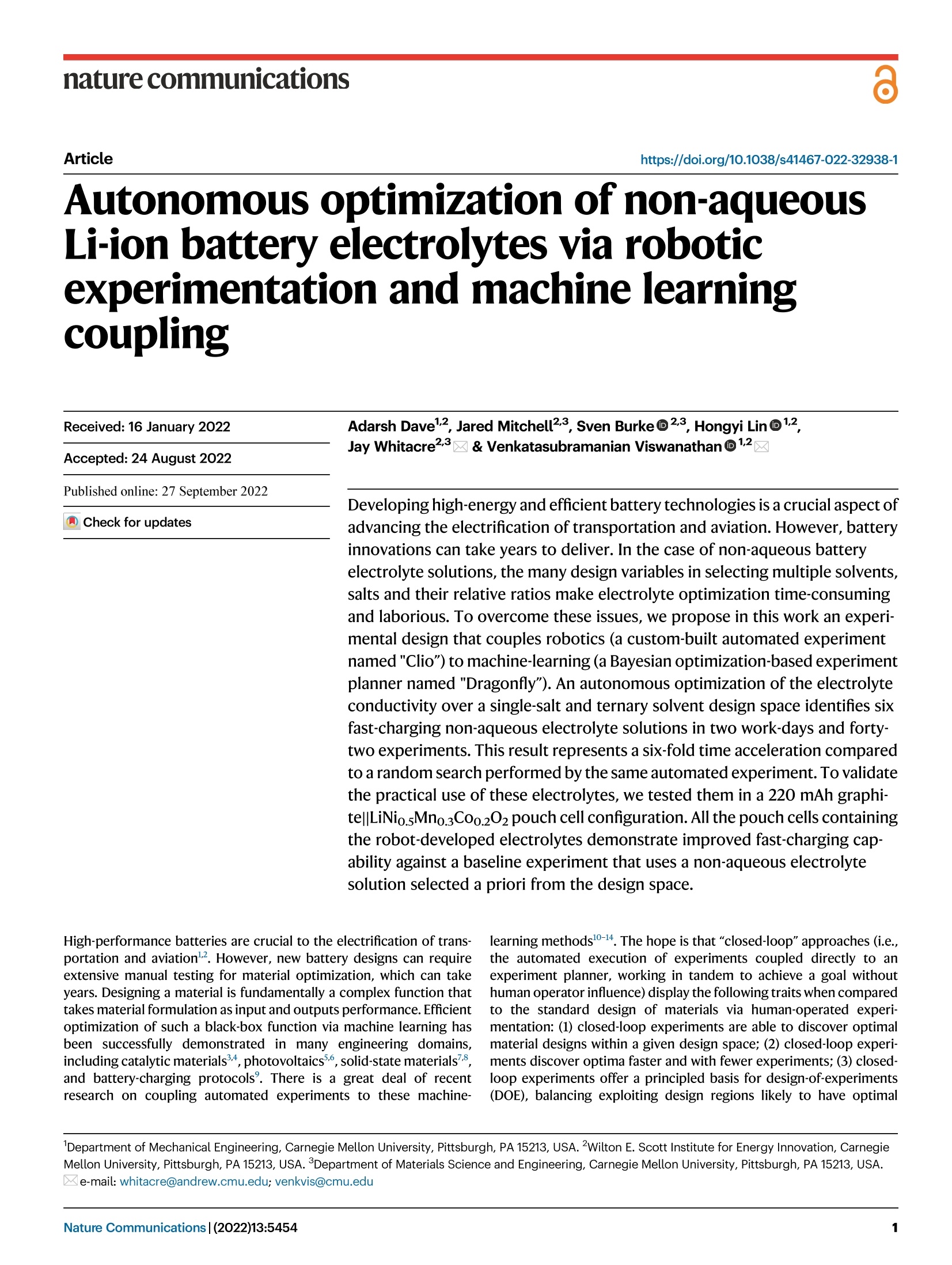
-
2/9
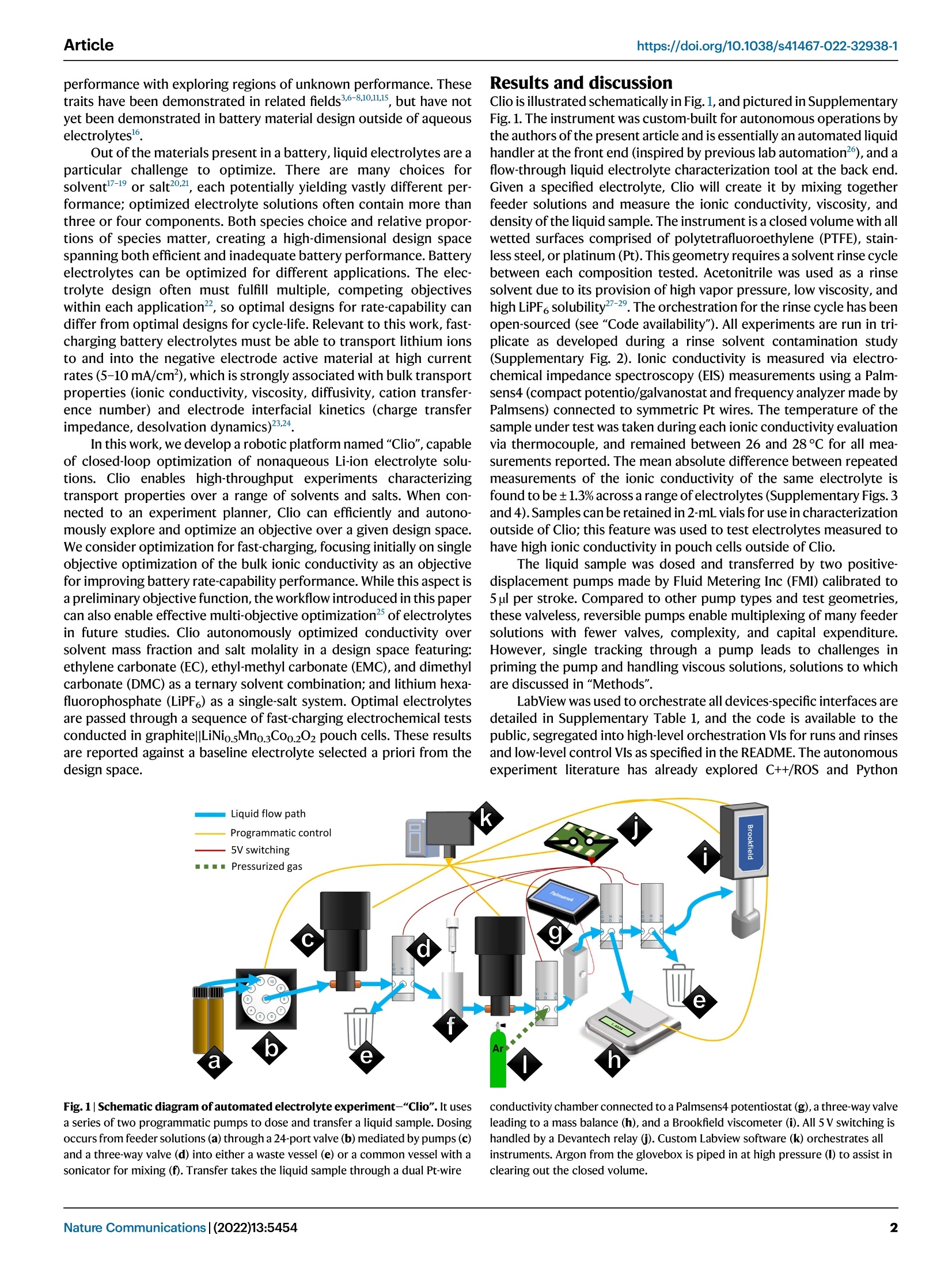
还剩7页未读,是否继续阅读?
继续免费阅读全文产品配置单
雷迪美特中国有限公司为您提供《【PalmSens4电化学应用】通过机器人实验和机器学习耦合,自主优化非水锂离子电池电解质》,该方案主要用于锂电池中电化学性能检测,参考标准《暂无》,《【PalmSens4电化学应用】通过机器人实验和机器学习耦合,自主优化非水锂离子电池电解质》用到的仪器有PalmSens4便携式电化学工作站。
我要纠错


